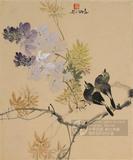宋緙絲荷花 軸
推薦分享
資源連結
連結到原始資料 (您即將開啟新視窗離開本站)後設資料
- 資料識別:
- 故絲000008N000000000
- 資料類型:
- 類型:緙繡
- 型式:靜態圖像
- 主題與關鍵字:
- 蓮荷
- 出版者:
- 數位化執行單位:國立故宮博物院
- 格式:
- 本幅 91.5x62.8公分、全幅 80.5公分
- 關聯:
- 石渠寶笈三編(延春閣),第六冊,頁2812&*國立故宮博物院緙絲,圖版28&*深藍地緙織淺設色荷花。中國古代的文學家認為荷花出污泥而不染,將之比喻為聖潔高雅的君子。此幅織幾株種植在池塘的荷花,荷花、荷葉挺出水面,臨風搖曳、姿態萬千,彷彿可以聞到芳芬高雅的花香。織法細緻勻整,墨筆添加及著色淡染的部份甚多,如花瓣、蓮蓬的鈎莖,荷葉、荷梗及水面波紋水草都運用墨色鈎勒輪廓,並以色淡染,用筆處如緙織而出,緙絲與繪畫難以分辨,在宋代緙絲作品較為少見。&*Lotus blossoms in light colors are woven against a dark blue background in this tapestry. Literary authors in ancient China considered the lotus as exemplifying purity for its ability to blossom untainted by the muddy waters in which it grows, thus symbolizing the pure and lofty gentleman. This work depicts several lotuses in a pond. The blossoms and leaves emerge from the water and sway with the breeze in various poses, so realistic as to make the viewer almost smell their subtle fragrance. The weaving here is fine and even, with numerous additions of brushwork and color washes. For example, ink was used to outline such areas as the flower petal, stalk of the seedpod, lotus leaf, lotus stem, and water ripples and plants, to which light colors were also added. The brushwork is just as refined as the weaving, making it difficult indeed to tell them apart. This is thus a relatively rare example of Sung dynasty tapestry.&*1.童文娥,〈緙絲荷花〉,收入童文娥主編,《緙絲風華 — 宋代緙絲花鳥展圖錄》(臺北:國立故宮博物院,2007年初版一刷),頁11。
- 管理權:
- 國立故宮博物院
授權聯絡窗口
- 國立故宮博物院圖像授權、出版授權、影音資料授權-申請流程說明
http://www.npm.gov.tw/zh-TW/Article.aspx?sNo=03003061






